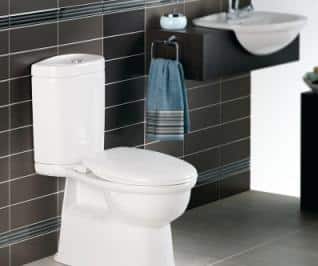Leaking Toilet
A leaking toilet is an all too-familiar problem for homeowners. Some telltale symptoms include an excessive water bill, the irregular sounds of water running or the presence of water around the pan. If left unaddressed, a leaking toilet can amount to an annual wastage of 70 kilolitres. Youch! That water bill is going to hurt.
Why Call Conrad Martens Plumbing?
- The fastest response in the industry
- Affordable & reliable service
- Knowledgeable tradesman & office support
- Vehicles stocked with a wide range of toilet rubbers and valves
- Leaking toilet specialists
- Full workmanship and quality guarantee
- Repair and replacement options

Leaking toilets manifest in a range of different shapes and sizes. Here at Conrad Martens Plumbing, we specialise in fixing leaking toilets, blocked toilets, servicing toilets and installing new toilet suites. Our team of experienced plumbers repair toilets on a daily basis and are ready to provide a speedy response throughout Brisbane. Some of the common problems we encounter include:
Inlet Valve
If you have a noisy, slow filling or constantly running toilet, it may be because of a defective fill valve/inlet valve. The inlet valve is found inside the toilet cistern and is responsible for topping up the water level in the cistern after each flush. There are three different types of inlet valves available on the market which include bottom entry, side entry or combination entry. Inlet valves usually suit most major brands like Caroma, Geberit, Ideal Standard, Porcher, Roca, Gemini, Johnson Suisse, Estilo, Stylus and Mondella. The most common problems we encounter with inlet valves include, dirt.grime stuck under the inlet washer, failed float mechanism or a split valve stem.
Outlet Valve
The outlet valve is the flushing mechanism that controls the release of water from the cistern. Typically, outlet valves either come in dual flush or single flush configuration. By restricting the water flow, it is possible to control how much water is dispersed into the toilet pan to flush waste. Some typical problems caused from by the outlet valve include:
- perished rubbers not forming a watertight seal
- a slow inlet speed not creating adequate pressure for the rubber to seal and
- a jammed or broken outlet valve
Water service
A toilet water service refers to pipework and isolation point which connects to mains water supply line to the toilet cistern. Typically, this connection is made using a braided stainless steel flexible connector. While flexible connections are a fast and cost-effective method, they also prone to leaks. Depending on the configuration, water services can also be replaced in copper pipe which is great for a long-term solution. If your toilet cistern or water service has a substantial leak, we recommend isolating the stop tap while not in use.
Washers and rubbers
Washers and rubbers can be found in abundance throughout any toilet suite. They are found in the cistern, on the flushpipe and on the pan collar. The most common include the cistern washers – aspro, inlet, outlet, suction, top hat, k rubbers and seating washers. The donut rubber seals between the toilet cistern and pan on close coupled toilet suites. To replace a donut rubber requires removing the toilet cistern. As all of these components are perishable, they often require regular maintenance.
External or other leaks
- Hairline crack in pan or system.
- Perished rubbers (i.e. doughnut rubber, key seal or flush pipe rubber).
- Blockage causing backpressure around pan collar.
- Leaking water service.
- Incorrect overflow level.
- Leaking water service, flexible connection or isolation valve.
- A ‘sticking’ or jammed button when flushing the toilet
Selecting a Replacement Toilet
Increased water efficiently is a key area focus for modern toilet design. Whilst older toilets can use up to 35 litres per flush, modern cisterns average only 6 litres per flush. Based on your drainage configuration, it is important to size a toilet with an appropriate volume.
The three main styles toilet suites available are categorised as close coupled, link and back to wall. A close coupled toilet consists of a cistern mounted directly on top of the toilet bowl. This is a popular and sleek design which hides the flush pipe. A link toilet suite features a separate pan and cistern linked by an exposed pipe. Back to wall cisterns are attached to the wall so there are no gaps between the toilet and the wall. dealing with the abundance of different toilet configurations, waste types and set out distances available it can be overwhelming choosing a new toilet. Depending on your bathroom and the style and look you are going for, we can help streamline the decision making process.
Waste Types and Set Out
The three main waste types to choose from are P trap, S trap and off-set pan collar. A P trap sits horizontally out through the wall. An S trap sits vertically down through the floor. Lastly, an off-set pan collar allows for some margin of error when installing a toilet suite. The PVC waste pipe comes through either the floor or the wall and aligns perfectly with the outlet of the pan. For an S trap toilet, the set out distance is the measurement from the wall to the centre of the toilet waste outlet. For a P trap toilet, it’s the distance from the floor to the centre of the outlet. Depending on the age of your home, set out distances can vary greatly. A lot of newly build properties have a standard set out of approximately 140-165mm.
In order to provide the best service possible, our vehicles stock a wide range of replacement parts from reliable manufacturers such as Caroma, Fluidmaster and Geberit. The ensures we can repair your toilet on the spot. With over 30 years’ experience servicing Brisbane and its surrounding suburbs, we’re well equipped to deal with all your toilet issues.
